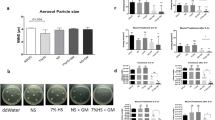Summary
Ampicillin concentrations in serum and bronchial secretions after oral administration of bacampicillin were evaluated. Twenty-eight hospitalized patients with acute bronchopulmonary infections received a single dose of 800 mg of bacampicillin. Samples of bronchial secretions were obtained during diagnostic bronchoscopy and blood samples were drawn simultaneously. Significant concentrations of ampicillin were found in bronchial secretions, the peak level, reached after approximately two hours, being 0.27 µg/ml on an average. The penetration of ampicillin into the bronchial secretions after the administration of bacampicillin could be correlated with the degree of bronchial inflammation, as illustrated either by macroscopic purulence or protein concentration in the secretions. The results suggest that bacampicillin is a useful drug in acute bronchopulmonary infections.
Zusammenfassung
Die Ampicillinkonzentrationen im Serum und im Bronchialsekret wurden nach oraler Gabe von Bacampicillin bestimmt. Achtundzwanzig hospitalisierte Patienten mit akuten bronchopulmonalen Infektionen erhielten eine Einzeldosis von 800 mg Bacampicillin. Proben von Bronchialsekret wurden während einer diagnostischen Bronchoskopie gewonnen, gleichzeitig wurden Blutproben abgenommen. In den Bronchialsekreten wurden signifikante Ampicillinkonzentrationen gefunden; der Spitzenspiegel der nach etwa zwei Stunden erreicht wurde, betrug dabei im Mittel 0,27 µg/ml. Die Penetration von Ampicillin in das Bronchialsekret nach Gabe von Bacampicillin schien mit dem Grad der bronchialen Entzündung korreliert zu sein, der an der makroskopisch erkennbaren Purulenz oder der Eiweißkonzentration des Sekrets bemessen wurde. Die Ergebnisse lassen annehmen, daß Bacampicillin ein geeignetes Medikament zur Behandlung von akuten bronchopulmonalen Infektionen darstellt.
Similar content being viewed by others
Literature
Bodin, N. O., Ekström, B., Forsgren, U., Jalar, L. P., Ramsay, C. H., Magni, L., Sjöberg, B. Bacampicillin: a new orally well absorbed derivative of ampicillin. Antimicrob. Agents Chemother. 8 (1975) 518–525.
Barza, M., Weinstein, L.: Penetration of antibiotics into fibrin in vivo. I-Comparison of penetration of ampicillin into fibrin clots, abscesses and “Interstitial fluid”. J. Infect. Dis. (1974) 59–65.
May, J. R., Delves, D. M. Treatment of chronic bronchitis with ampicillin. Some pharmacological observations. Lancet I (1965) 929–933.
Bergogne-Berezin, E., Lambert-Zechovsky, N., Kafe, H. Etude pharmacocinétique comparative de divers antibiotiques dans les sécrétions bronchiques. Med. Mal. Infect. 6 (1976) 4 134–137.
Pennington, J. E. Kinetics of penetration and clearance of antibiotics in respiratory secretions: In:Kirkpatrick, C. H., Reynolds, H. Y. (ed): Immunologic and infectious reactions in the lung. Marcel Dekker Inc., New York, 1976.
May, J. R., May, D. S. Bacteriology of sputum in chronic bronchitis. Tubercle 44 (1963) 162.
Grove, D. C., Randall, W. A. Assay methods of antibiotics. Medical Encyclopedia, New York, 1955.
Author information
Authors and Affiliations
Rights and permissions
About this article
Cite this article
Bergogne-Berezin, E., Berthelot, G., Kafe, H. et al. Penetration of ampicillin into human bronchial secretions. Infection 7 (Suppl 5), S463–S464 (1979). https://doi.org/10.1007/BF01659772
Issue Date:
DOI: https://doi.org/10.1007/BF01659772




